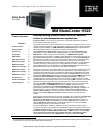
Workhorse 2-socket single- or dual-core Intel Xeon blade server
Please see the Legal Information section for important notices and information.
1.
Sales Guide
June 2006
IBM BladeCenter HS20
Product Overview
CONTENTS
Product Overview 1
Selling Features 2
Key Features 4
Key Options 12
HS20 Images 13
HS20 Specifications 13
BladeCenter Images 15
BladeCenter Specs 16
BladeCenter H Images 17
BladeCenter H Specs 18
BladeCenter T Images 19
BladeCenter T Specs 19
The Bottom Line 20
For More Information 22
Legal Information 22
Uncompromising 2-socket blade server for business-
critical or telecommunications applications
[Target Customers: Front-and mid-tier applications requiring high performance, enterprise-
class availability and extreme flexibility.]
Today’s data center environment is tougher than ever. Customers are looking to reduce IT cost,
complexity, space requirements, power consumption and heat output, while increasing flexibility,
utilization and manageability. The IBM
®
BladeCenter
®
HS20 blade server, combined with the
various BladeCenter chassis, can help them accomplish all of these goals.
A single BladeCenter or BladeCenter H chassis supports up to 14 hot-swappable 30mm
HS20 blades in only 7U (BladeCenter) or 9U (BladeCenter H) of rack space. (A rugged 8U
BladeCenter T chassis supports up to 8 HS20 blades in a NEBS-3/ETSI-compliant
telecommunications environment.) In addition to the blade servers, these chassis also hold up to
four (BladeCenter/BladeCenter T) communication switches, or up to ten switches/bridges
(BladeCenter H) internally. Not only can this save significant data center space (and therefore
the cost of floor space and rack hardware) compared to 1U servers, it also consolidates
switches/bridges and cables for reduced complexity and lower cabling costs, and allows clients
to manage everything in the solution as one. Using a BladeCenter chassis, up to 84 HS20
servers (168 processors) can be installed in one industry-standard 42U rack but the value of
BladeCenter extends far beyond high density data center environments.
Reducing an entire server into as little as .5U of rack space does not mean trading features and
capabilities for smaller size. Each HS20 blade server offers features comparable to many 1U
rack-optimized full-featured servers: Up to two of the latest single- and dual-core Intel
®
Xeon
®
processors, including full-performance/low-power models. The single-core Xeon processor is
designed with 1MB or 2MB (model-specific) of L2 cache, a leading-edge 800MHz front-side bus
(FSB), 64-bit extensions (EM64T) and Hyper-Threading Technology, to help provide
customers with the computing power they require to match their business needs and growth.
The dual-core Xeon processor provides two cores with matching 1MB L2 caches, for increased
performance at a lower power draw than the single-core version. Both versions of the HS20
support up to 16GB of 400MHz PC2-3200 ECC (Error Checking and Correcting) double data
rate II (DDR2) memory (in 4 DIMM slots) with optional Chipkill
™
protection, for high
performance and reliability. Integrated dual Gigabit Ethernet
1
controllers are standard,
providing high-speed data transfers and offering load-balancing and failover capabilities. Via
optional expansion cards, each blade can connect to additional Ethernet, Myrinet, Fibre
Channel, iSCSI, InfiniBand
™,
and other high-speed communication switches housed in the
chassis. Optional 2-port Expansion Cards add additional fabrics to the HS20 server as
needed.
All models offer impressive features at an equally impressive price, including up to two Ultra320
SCSI or SAS hard disk drives (model dependent, with RAID-1 disk mirroring support. An
optional 30mm SCSI Expansion unit connects to a blade (model-dependent) to provide an
additional two SCSI HDDs, with hot-swap and enhanced RAID-1E support. Moreover, the
HS20 is optimized for diskless operation, offering each blade server access to essentially
unlimited storage capacity via Fibre Channel or iSCSI.
The various BladeCenter chassis are designed to monitor environmental conditions in the
chassis and each blade and send alerts to the administrator. Advanced standard features, such
as Predictive Failure Analysis
™
, light path diagnostics, hot-swap redundant power supplies
and blower modules with Calibrated Vectored Cooling
™
; IPMI 1.5 support, including highly
secure remote power on/off; text-console redirect over LAN, a management module
(upgradeable to hot-swap/redundant), IBM Director management software and IBM
1
Actual data transfer speed will vary and is often less than the maximum possible. Gigabit Ethernet transfer speed requires support
on both system and server, and appropriate network infrastructure.


















